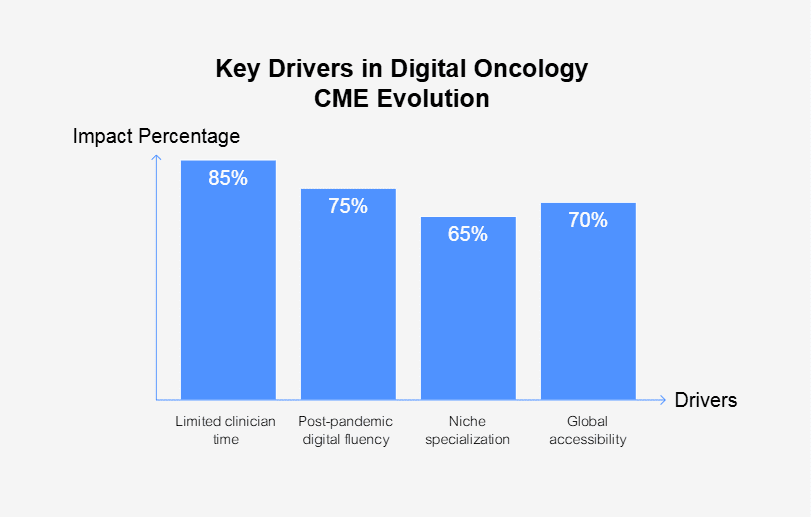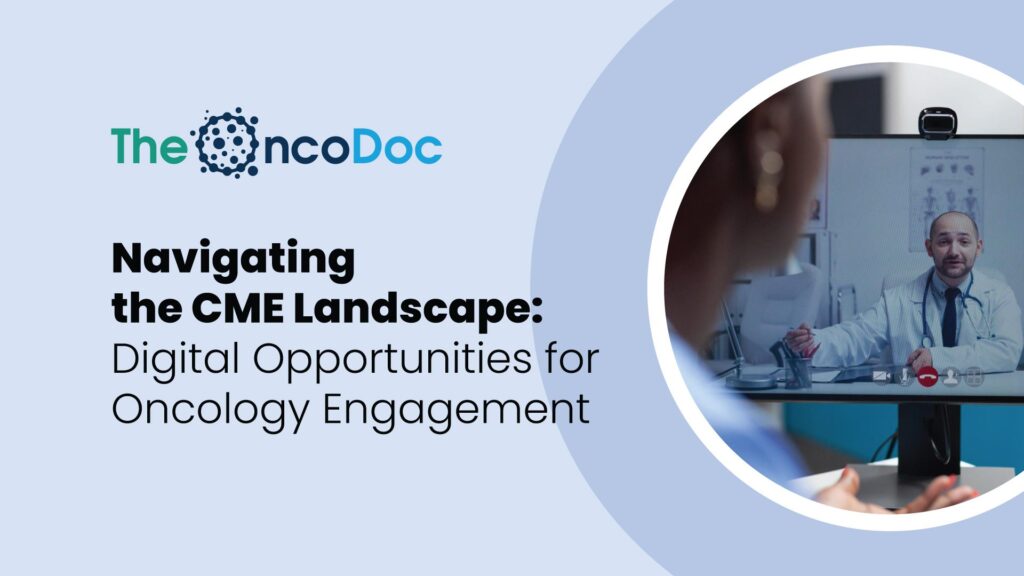Introduction: CME as a Strategic Lever, Not a Formality
Continuing Medical Education (CME) plays a pivotal role in keeping oncology professionals updated with the latest clinical advancements. With treatment protocols, diagnostics, and standards of care evolving rapidly, CME serves as a crucial channel for knowledge transfer. Yet, how it’s delivered has not always kept pace with modern expectations.
Traditional formats like static webinars or lengthy PDFs often fall short of meeting the demands of today’s time-constrained oncologists. Instead, there’s a growing preference for flexible, interactive, and personalized learning experiences- offered digitally. When executed with intention and ethics, digital CME can go beyond compliance, fostering trust and long-term engagement.
This article explores how oncology-focused brands and educators can embrace the digital CME landscape to connect more meaningfully with healthcare professionals (HCPs).
The Evolution of CME in Oncology
The CME model has shifted significantly due to multiple forces:
- Limited clinician time necessitating on-demand and mobile-first learning
- Post-pandemic digital fluency among even traditionally offline audiences
- Niche specialization within oncology creating demand for focused content
- Global accessibility enabling broader participation beyond geographic limits
As a result, CME is becoming more than a scheduled activity- it’s a curated learning journey.

How to Create Value-Driven CME Experiences in Oncology
To truly resonate with oncologists, digital CME programs must be thoughtful, relevant, and adaptable to clinical needs. Here’s how:
1. Customize Content for Different Oncology Roles
A radiation oncologist will not have the same educational priorities as a hemato-oncologist or a general practitioner referring oncology cases. Educational modules should be personalized based on:
- Clinical subspecialty
- Experience level
- Practice setting (urban hospital vs. rural clinic)
- Prior interaction with CME content
Segmentation improves content relevance and participation rates.
2. Embrace Microlearning and Modular Formats
Busy clinicians often prefer short, self-contained learning units over extended lectures. Consider:
- Quick video explainers (2–5 minutes)
- Visual summaries or infographics
- Case-based quizzes
- Voice-note recaps distributed via messaging platforms
These formats boost retention and enable learning in short windows of availability.
3. Make CME Interactive and Clinically Relevant
Interactive content keeps users engaged and helps with knowledge application. Techniques that work include:
- Virtual tumor boards with scenario-based decision-making
- Live polling during webinars
- Simulation-based assessments
- Real-time feedback quizzes
Adding clinical context ensures the education translates to practice.
4. Prioritize On-Demand and Mobile Accessibility
Oncologists need CME they can access anytime, anywhere. Make sure:
- Content is mobile-friendly
- Courses are modular and can be completed in stages
- Platforms support offline access or easy downloads for later viewing
Convenience increases course completion rates and return visits.
5. Collaborate with Credible Institutions and Experts
For maximum impact and trust, work with:
- Medical associations and academic institutions
- Reputable CME platforms
- Recognized clinical experts in oncology
Ensure all content is reviewed, unbiased, and clearly states sponsorship if applicable.
6. Turn One-Time Events into Ongoing Education
Avoid siloed webinars or one-off sessions. Instead:
- Offer follow-up content like toolkits or guideline summaries
- Create sequences of related modules around key topics
- Invite learners to join communities or forums for continuous learning
This positions your brand or organization as a sustained knowledge partner.

Ethical Considerations in Digital CME Delivery
CME should always put education before promotion. To ensure ethical engagement:
- Keep branded content and educational content separate
- Follow accreditation standards (ACCME, EACCME, MCI, etc.)
- Be transparent about sponsorship and content authorship
- Comply with data privacy regulations such as GDPR and India’s DPDP Act
Maintaining integrity is essential for long-term credibility.
Real-World Example: Boosting Engagement with Microlearning
An oncology-focused pharmaceutical firm partnered with a regional cancer care network in Southeast Asia to deliver mobile-first CME on immunotherapy. The strategy included:
- Weekly 3-minute expert videos
- WhatsApp distribution with timely reminders
- Case-based modules with interactive elements
- Post-module assessments eligible for CME credit
Results:
- 42% of participants opted in for future CME offerings
- Course completion increased from 22% with traditional formats to 68% using microlearning

Conclusion: CME as a Tool for Partnership and Progress
In oncology, education is not just about disseminating information- it’s about enabling better patient care through timely, credible learning. Digital CME offers an ethical and effective route to engage clinicians, build trust, and contribute to professional development.
Organizations that treat CME as a strategic, learner-first experience- rather than a regulatory formality will position themselves as valuable allies in oncology care.
The Oncodoc team is a group of passionate healthcare and marketing professionals dedicated to delivering accurate, engaging, and impactful content. With expertise across medical research, digital strategy, and clinical communication, the team focuses on empowering healthcare professionals and patients alike. Through evidence-based insights and innovative storytelling, Hidoc aims to bridge the gap between medicine and digital engagement, promoting wellness and informed decision-making.



